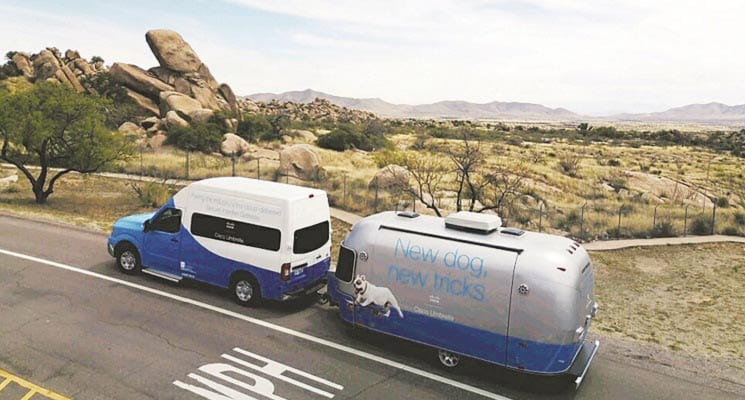by Cynthya Porter
For myriad reasons, sometimes, the tradeshow floor isn’t the right choice for reaching a company’s target market.
In many organizations, sending employees to tradeshows has been among the first and most frequent casualties of budget cuts to trim the corporate bottom line. But for companies who rely on face-to-face marketing to sell their products, that downturn in attendance has the potential to be devastating to their own sales and marketing success.
Alternately, for some would-be exhibitors, the cost of bringing demo products to a show is prohibitive due to the bulk or fragility of them, so they must come up with inventive means to get their wares in front of buyers. And for some businesses, coming up with face-to-face marketing alternatives to tradeshows fits the company’s vibe or suits a particular product’s storyline.
For all those situations, mobile exhibiting just might be the right road to go down, so to speak.
Decades ago, mobile exhibiting meant one of two things: a giant rolling box wrapped with some branding and pulled by a semi-truck, or a kitschy attention-getter like the Oscar Meyer Wienermobile. And though that rolling box might have had some demo equipment in it or the Wienermobile might set up somewhere and distribute hot dogs, mobile exhibiting, for the most part, was not where companies were doing any kind of serious business.
But now, ProExhibits vice president of marketing Paul Miller says, only the imagination can limit what companies can accomplish using traveling exhibits and there is more interest in it than ever before as companies look for innovative ways to get in front of current and potential clients. “It’s a trend that has been increasing over the past 15 years,” he says, “because it’s a way to bring a brand to multiple clients in a way that is convenient for them.”
To wit, when a trailer decked out with product demo stations and a cushy meeting room pulls into the parking lot of a business, there are very few barriers that keep the C-level executives from being able to walk across the parking lot for a few minutes to check it out. Compared to the challenges of creating that opportunity at a tradeshow, it’s a win for those mobile exhibitors. But as a bonus, most mobile exhibits can serve double duty right on the tradeshow floor as well, allowing a company to have the best of both worlds without having to invest in a separate display setup.
A mobile exhibit today might be so tricked out that, once inside, visitors lose themselves in the environment and forget that they are standing in a trailer, Miller says. “The technology part of mobile exhibiting is a lot more sophisticated. Now those setups have access to hi-speed internet and large flat-screen TVs, and the generators being used to power them are much smaller and quieter,” he says. “You can literally design anything from pop-up stores to meeting suites to demo lounges and outfit them exactly the way you would in a stationary place of business.”
With the exploding number of ways you can outfit a mobile exhibit, the variety of vehicles being used for road shows has expanded dramatically as well, says Miller. In years past, 53-foot semi-truck trailers were the standard for mobile exhibits, but now, clients are choosing between a wide array of vehicles that come with various customization options and price points, from Sprinter vans to Airstream trailers and beyond.
 When Carmela Robertson (pictured right), director of global events for Cisco, pitched an Airstream trailer road show to her supervisors a couple of years ago, it was because the idea of mobile exhibiting fit perfectly with the company’s product promise of digital security anywhere for its clients. The company didn’t use it to replace its presence at tradeshows, she says, but rather to augment their traditional exhibiting program. The company would bring its customized Airstream trailer right into its booth on the show floor, but then would schedule it for stops around the country in the meantime.
When Carmela Robertson (pictured right), director of global events for Cisco, pitched an Airstream trailer road show to her supervisors a couple of years ago, it was because the idea of mobile exhibiting fit perfectly with the company’s product promise of digital security anywhere for its clients. The company didn’t use it to replace its presence at tradeshows, she says, but rather to augment their traditional exhibiting program. The company would bring its customized Airstream trailer right into its booth on the show floor, but then would schedule it for stops around the country in the meantime.
Robertson says there is a steep learning curve when it comes to mobile exhibiting, as the success of a program depends largely on the willingness of various sales departments to integrate it into their existing routines. But at a company where mobile exhibiting programs have not existed before, she says, training and advocacy for the program are required if it is going to catch on within departments. “Someone needs to be on the program specifically to promote it to the sales force,” she says. That person would also be the ideal candidate for managing the booking of the Airstream to maximize the efficiencies available.
At Cisco, sales teams could request that the trailer be brought to events around the country, and deftly navigating the logistics and expenses of crisscrossing the country is another discipline that takes time to master when launching a road show, she says. “We definitely learned a lot the first year and I think that year could have been more cost effective. But having the trailer on a multi-year contract allowed us to see some savings,” Robertson explains.
Costs for mobile exhibiting can vary as widely as the types of vehicles and number of industries that might avail themselves of the marketing method, Miller says. Most companies rent the vehicle from turnkey suppliers like ProExhibits, he says, and the size of the vehicle, the amount of customization, the number of and distance between stops the vehicle will have, and the accompanying setup for the roadshow events (such as auxiliary tents, food trucks, etc.) will all dictate what kind of investment a firm will make into a mobile exhibiting program. On the lowest end, he said, a roadshow with a customized van could cost as little as $10,000, but a tricked-out semi-truck trailer running on an elaborate schedule across the country could cost more than $1 million.
Expense and variables and learning curves aside, for companies willing to tackle the endeavor, mobile exhibiting can be worth the effort, Robertson says. “We tracked its performance in the pipeline and it did do very well so we could definitely justify its use,” she says. “We chose an Airstreamer because it was unique—an attention getter, and it drew people to us even when we were just leveraging it on the tradeshow floor.” The mobile exhibit enjoyed similar popularity out on the road, both for its iconic form and for the extreme convenience of being able to sample Cisco’s security products without really having to leave the office. Beyond that, Robertson says, when Cisco promised clients it could give them digital security anywhere, the company really put its money where its mouth was by doing so from a mobile display parked outside.
This story originally appeared in the May/June issue of Exhibit City News, p. 42. For original layout, visit https://issuu.com/exhibitcitynews/docs/ecnflipbook_mayjune_2019_web































